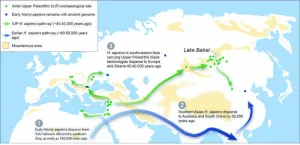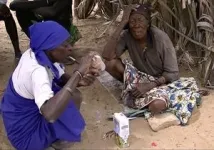(Press-News.org) LAWRENCE — It’s an Ice Age mystery that’s been debated for decades among anthropologists: Exactly when and how did the flow of Homo sapiens in Eurasia happen? Did a cold snap or a warming spell drive early human movement from Africa into Europe and Asia?
A new study appearing in Science Advances compares Pleistocene vegetation communities around Lake Baikal in Siberia, Russia, to the oldest archeological traces of Homo sapiens in the region. The researchers use the “remarkable evidence” to tell a compelling story from 45,000-50,000 years ago with new detail: how the first humans migrated across Europe and Asia.
The new pollen data suggest warming temperatures supported forests that expanded into Siberia and facilitated early human migration there, at roughly the same time as more and western areas of Eurasia.
“This research addresses long-standing debates regarding the environmental conditions that early Homo sapiens faced during their migration into Europe and Asia around 40,000 to 50,000 years ago,” said co-author Ted Goebel, professor of anthropology at the University of Kansas. “It provides critical insights into environmental conditions at Lake Baikal, using pollen records to reveal surprising warmth during this period.”
Indeed, the pollen data suggest that the dispersal of people occurred during some of the highest temperatures in the late Pleistocene, which also would have featured higher humidity. The ancient pollen record shows coniferous forests and grasslands characterized the region, able to support foraging and hunting by humans. Goebel said the environmental data, combined with archeological evidence, tell a new story.
“This contradicts some recent archaeological perspectives in Europe,” said the KU researcher. “The key factor here is accurate dating, not just of human fossils and animal bones associated with the archaeology of these people, but also of environmental records, including from pollen. What we have presented is a robust chronology of environmental changes in Lake Baikal during this time period, complemented by a well-dated archaeological record of Homo sapiens’ presence in the region.”
Goebel’s collaborators were lead author Koji Shichi of the Forestry and Forest Products Research Institute in Kochi, Japan; Masami Izuho of Tokyo Metropolitan University, Hachioji, Japan; and Kenji Kashiwaya of Kanazawa University, Kanazawa, Japan.
While the pollen analysis was carried out in Japan, Goebel and Izuho tied the pollen data to important evidence in the archeological record of early human migration. Goebel said the emergence of full-fledged Homo sapiens in the archaeological record corresponds to changes in culture and behavior. Early modern humans of this period were making stone tools on long, slender blades, working bone, antler and ivory to craft tools — including some of the first bone needles with carved eyelets for sewing and early bone and antler spear points.
“Some of us argue that as the anatomical changes were occurring, as evidenced by the fossil record, there was a simultaneous shift in behavior and cognition,” Goebel said. “These early humans were becoming more creative, innovative and adaptable. This is when we start to observe significant changes in the archaeological record, such as cave paintings. We also find mobile art, like the early carvings known as Venus figurines. In Central Europe, there’s even an ivory sculpture dating back to this early period, depicting a lion-headed man. It’s not just replicating nature; it’s about creative expression, inventing new things, exploring new places.”
At least one human bone has been found in the region that dates to the era, according to the KU researcher.
“There is one human fossil from Siberia, although not from Lake Baikal but farther west, at a place called Ust’-Ishim,” Goebel said. “Morphologically, it is human, but more importantly, it’s exceptionally well-preserved. It has been directly radiocarbon-dated and has yielded ancient DNA, confirming it as a representative of modern Homo sapiens, distinct from Neanderthals or Denisovans, or other pre-modern archaic humans.”
Goebel said the earliest human inhabitants of the area likely would have lived in extended nuclear families or small bands, as they seem to have done in other areas of Eurasia. But because so much archeological evidence is degraded, it’s difficult to know with certainty.
“At Ust’-Ishim in Siberia, we have evidence of a fully modern human co-existing with the sites we’ve been discussing,” he said. “However, Ust’-Ishim was an isolated discovery, found by geologists eroding from a riverbank. We lack information about its archaeological context, whether it was part of a settlement or simply a solitary bone washed downstream. Consequently, linking that single individual to the archaeological sites in the Baikal region is tenuous — do they represent the same population? We think so, but definitely need more evidence.”
END
Pollen analysis suggests peopling of Siberia and Europe by modern humans occurred during a major Pleistocene warming spell
2023-09-22
ELSE PRESS RELEASES FROM THIS DATE:
Many low- or middle-income countries unprepared for the battle against cardiovascular disease
2023-09-22
Most healthcare facilities in many Low- and Middle-income Countries (LMICs) are unprepared to treat patients with cardiovascular diseases – despite these conditions leading to millions of people dying prematurely every year, a new study reveals.
Experts analysed health survey data from eight LMICs across four World Health Organisation world regions to discover that most facilities are unprepared to deliver services to treat or manage cardiovascular disease risk factors (CVDRF) such as diabetes and hypertension.
However, the increased ...
Probing the deep genetic structure of Africa
2023-09-22
Africa is the birthplace of modern humans and the continent with the highest level of genetic diversity. While ancient DNA studies are revealing some aspects of the genetic structure of Africa before the spread of food production, issues concerning DNA preservation have limited the insights from ancient DNA. Hoping to find clues in modern populations, researchers from a Portuguese-Angolan TwinLab ventured into the Angolan Namib desert – a remote, multi-ethnic region where different traditions met. “We were able to locate groups which were thought to have disappeared more than 50 years ago”, states Jorge ...
UC San Diego Health named national leader in delivering high-quality patient care
2023-09-22
UC San Diego Health has been recognized as a top performer in the 2023 Bernard A. Birnbaum, MD, Quality Leadership Ranking by Vizient, Inc. for its excellence in delivering high-quality patient care. This achievement represents the fifth consecutive year that UC San Diego Health has been ranked among the top ten academic health systems in the United States.
“This incredible accomplishment is a direct result of the exceptional care provided each day by our multidisciplinary teams throughout our health system,” said Patty Maysent, CEO of UC San Diego Health. “We are extremely proud to have achieved this national honor now for five years in a row, which ...
Louisiana Cancer Research Center Associate Director of Administration Sven Davisson named Treasurer of Association of Independent Research Institutes
2023-09-22
Louisiana Cancer Research Center (LCRC) Associate Director of Administration Sven Davisson has been appointed to the board of the Association of Independent Research Institutes (AIRI).
During his two-year term, Davisson will serve as the organization’s treasurer. He has served the organization in various roles since 2012.
AIRI is a national association of independent, not-for-profit biomedical and behavioral research institutes whose mission is to enhance the ability of its members to improve human health and advance knowledge through networking, education, and involvement in the development of science ...
Discovery in mosquitoes could lead to new strategy against dengue fever and other mosquito-borne vectors
2023-09-22
Researchers from the Johns Hopkins Malaria Research Institute at the Johns Hopkins Bloomberg School of Public Health have made an important finding about Aedes aegypti mosquitoes—one that could one day lead to better methods for reducing the mosquito-to-human transmission of dengue, yellow fever, Zika, and other harmful and sometimes deadly viruses.
Ae. aegypti mosquitoes do not succumb to these viruses when infected and continue to move and feed normally. As such, the ...
The potential of solar cars in the world
2023-09-22
A new study, modeling the potential of solar-powered vehicles in the urban context in 100 cities across the world, shows that solar energy provides a range between 11 and 29 km per day, reducing charging needs by half.
Despite the rapid adoption of electric vehicles, the transport sector is still responsible for around a third of global carbon dioxide (CO2) emissions worldwide. Therefore, to achieve decarbonization targets, it is required to significantly decrease the emissions associated with mobility.
Integrating photovoltaic modules into ...
Fruit flies offer clues to how brains make reward-based decisions
2023-09-22
Like many collectors of L.P. records, James Fitzgerald’s brother-in-law has a favorite store where he consistently finds the best vinyl for his collection. But there are times when he spends hours at the store and comes up empty. He also knows that occasionally he should venture to the record store on the other side of town, where he sometimes scores a hard-to-find gem that was stocked since his last visit.
Fitzgerald’s brother-in-law is making a calculation: weighing probable outcomes to guide his behavior. His favorite record store ...
Pioneering health tracker for stroke survivors will use the body to transmit data
2023-09-22
AMHERST, Mass.—An interdisciplinary team led by University of Massachusetts Amherst researchers has been awarded $1.14 million over four years by the National Institutes of Health (NIH) to develop a revolutionary way of tracking body movements, with a primary application in stroke survivors’ rehabilitation and huge potential for future applications across a wide range of disciplines, health-related and beyond.
More than 795,000 Americans suffer from strokes annually, and nearly 80% of stroke survivors experience some degree ...
Brazilian researchers develop method of purifying water contaminated by glyphosate
2023-09-22
Researchers at São Paulo State University (UNESP) in Brazil have developed a strategy for removing glyphosate, one of the world’s most frequently used herbicides, from water. Inspired by the concept of the circular economy, the technique is based on sugarcane bagasse, a waste material produced by sugar and ethanol plants.
“Isolated and chemically functionalized sugarcane bagasse fibers can be used as adsorbent material. Glyphosate adheres to its surface and is removed as a water contaminant by filtration, decantation or centrifugation,” Maria ...
Vizient awards UCSF Health top marks for quality patient care
2023-09-22
Hospital quality ratings assess safety, equity and effectiveness in hospitals nationwide
Vizient Inc. has named UCSF Health as a Top Performer for its high-quality patient care in the 2023 Bernard A. Birnbaum, MD, Quality Leadership Ranking.
This is the second year in a row that Vizient has recognized UCSF Health as a leader in health care quality. This year, UCSF Health ranked seventh among comprehensive academic medical centers, out of 116 medical centers that were evaluated in that cohort and ...








